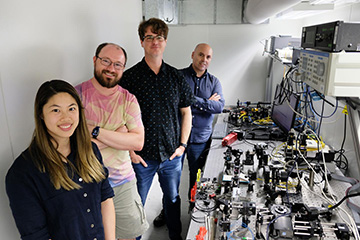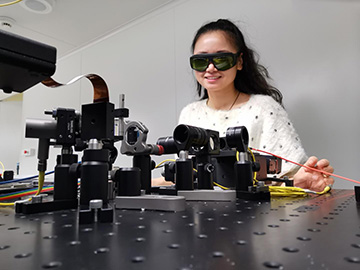
Left to right: Researchers Alison Wong, Christopher Betters, Barnaby Norris and Sergio Leon-Saval in the photonics lab at the Sydney Nanoscience Hub, University of Sydney. [Image: University of Sydney]
Adaptive-optics systems require wavefront sensors, but these sensors produce their own challenges, especially when their users are seeking spectra instead of images. Researchers at an Australian university have devised a new kind of wavefront sensor that directly measures phase and intensity and can feed light signals straight into a spectrograph as well as a camera (Nat. Commun., doi:10.1038/s41467-202-19117-w).
The scientists at the University of Sydney have tested this sensor, based on optical fiber technology called a “photonic lantern,” both with numerical modeling and on a tabletop proof-of-concept experiment. Besides the photonics technology, the sensor relies on artificial-intelligence algorithms to reconstruct images at the focal plane.
Phase and intensity
To measure an incident wavefront, such as light passing through a turbulent layer of atmosphere and entering a telescope, adaptive-optics systems require both phase and intensity information from a beam of light. Imaging detectors, however, capture only the intensity of light, not its phase. To gather the missing information, researchers must add a second wavefront sensor in the pupil plane of the system and split the beam going through the instrument. This duality adds further complications, such as aberrations that affect one light path but not the other. Also, wavefront sensors in the pupil plane fail to remove some types of wind-caused aberrations that plague astronomical imaging.

Co-author and graduate student Fiona (Jin) Wei from the School of Physics at the University of Sydney, Australia. [Image: University of Sydney]
To solve this problem, the Sydney team built a wavefront sensor incorporating a photonic lantern: an adiabatically mounted bouquet of single-mode fiber cores. As described by one of the researchers in the May 2019 OPN, the group of identical, uncoupled single-mode fibers acts as a multimode fiber core on one end and channels the signals into an output array of single-mode fiber cores on the other end.
In the case of astronomical spectroscopy, the faint signal from a spectrograph is often conveyed through a multimode fiber. The photonic lantern wavefront sensor breaks up the feed into a high-dispersion single-mode spectrograph, which astronomers prefer for the high-precision spectral line measurements needed to detect extrasolar planets or perhaps even characterize their physical properties.
Reconstructing the wavefront
The neural-network algorithm helps with wavefront reconstruction, since the nonlinear correlations between input phase and output intensity are difficult to tease out and calculate at the short latency speeds required in adaptive optics.
The Sydney team plans to deploy this new technology at the National Astronomical Observatory of Japan’s 8.2-m-aperture Subaru telescope on Mauna Kea in Hawaii, USA.
